Abstract
This paper discusses the status of island phenomena in Avatime, an endangered Kwa language of Ghana. We focus on clausal adjuncts, specifically noun complement clauses (NCCs). We show that while standard adjuncts are strong islands in Avatime, NCCs allow argument extraction. We suggest that this is related to the fact that NCCs in Avatime are not a type of relative clause. Instead, NCCs involve a kind of serial verb construction, which independently allows for extraction.
1. Introduction
This paper investigates the properties of noun complement clauses (NCCs) in Avatime, like (1a):

The English NCC in (1b) is initially useful because it appears to involve roughly the same elements as the Avatime: a noun followed a complementizer and ‘modifying’ clause that specifies the content of the noun. In investigating Avatime NCCs, we approach the data in (1a) from two perspectives. First we take a close look at NCCs in Avatime and argue that, despite initial appearances, they do not correspond structurally to the English construction in (1b). Instead, we point to a construction found in Avatime (and other Kwa languages), verb serialization, as a key to analyzing NCCs. Second, we turn to the extraction properties of Avatime NCCs and how these fit into the typology of islands and analyses of such phenomena. Specifically, we discsuss how the serialization analysis of Avatime NCCs relates to extraction facts and the properties of extraction from adjuncts crosslinguistically (Truswell (2007) and Truswell (2011)).
Since Ross (1967), a great deal of syntactic research has aimed to characterize the properties that render certain domains opaque for extraction. One such constraint is the complex noun phrase constraint (CNPC), which prohibits extraction from a clause that modifies a noun. This has generally been taken to apply to two distinct cases, namely, relative clauses (henceforth RCs) like (3), and clausal “complements” to nouns (NCCs) in (4):

| (3) | a. | Phineas knows a girl [who is jealous of Maxine] (Ross 1967, 4.14a, adapted) |
| b. | Who does Phineas know a girl w[ho is jealous of __]? (Ross 1967, 4.15a, adapted) |
| (4) | a. | I believed the claim [that Otto was wearing this hat]. (Ross 1967, 4.17a, adapted) |
| b. | * The hat which I believed the claim [that Otto was wearing __ ] is red. (Ross 1967, 4.18a, adapted) |
Although the CNPC covers both cases, in practice, they differ in status. RCs and the status of the CNPC have been the subject of intensive study in the Generative tradition, leading to many noted (at least apparent) exceptions (In this volume alone see, Schurr et al. (2024), Korsah and Murphy (2024), Smith (2024), Hein (2024); additionally, (Chomsky 1982; Cinque 2010; Engdahl 1980; Erteschik-Shir 1973; Kuno 1976; Kush et al. 2013; McCawley 1981; Sichel 2018, a.o.)).
In contrast to the pattern in (4), this paper introduces data from Avatime, as shown in (5), which appears to involve extraction from N-complement clauses similar to (4).

At first glance, the acceptability of (5) would seem to require that we modify our theory to allow extraction out of some noun-complement clauses, assuming that this case involves the structure in (6).

Another alternative is that we maintain the CNPC and demonstrate that (6) is not the right analysis. This is similar to the approach taken in Sichel (2018), which argues that relative clauses are structurally ambiguous. One RC structure is derived via raising of the head noun from the lower clause into the higher clause, which results in a structure akin to wh-islands, independently considered weak islands. Sichel argues that all RCs that are transparent for A-bar extraction are actually raising RCs.
In the same spirit, we suggest that (5) should not be analyzed as (6). Instead, we suggest that (5) actually contains a serial verb construction, in line with Major and Torrence (2020) and Major (2021), which has the appearance of an NCC. We argue that the element si, which appears in a position similar to a complementizer, is actually an instance of the verb si “say” appearing in the second position of a serial verb construction.

By adopting the structure in (7) for (5), it no longer involves extraction from a “complex NP”; instead, it involves extraction out of an adjunct. Adjuncts have similarly been shown to be selective islands, like wh-islands. Thus, in the spirit of Sichel (2018)’s analysis of RC CNPC violations, we suggest that these serializations are weak islands, which allow extraction of arguments, but not adjuncts. As a result, we suggest that cases involving si “say” clauses do not involve the CNPC at all. It is also well known that low clausal adjuncts are often transparent for extraction (e.g., Privoznov 2021, 2022; Truswell 2007, 2011), making the fact that these domains are selectively transparent less surprising.
In this paper, we discuss two aspects of island-related movement in Avatime. First, we present a case study of a type of CNPC violation found in Avatime. Second, we briefly discuss the properties of movement and islands more generally by comparing the facts of Avatime to patterns found in other languages. The paper is organized as follows. Section 2 presents background on the relevant corners of Avatime grammar, including the syntax of questions and serial verbs. Section 3 turns to different island types in Avatime and shows that Avatime does exhibit island phenomena and gives initial theoretical treatments. Section 4 concludes the article.
2. Background
2.1. Language Background
Avatime (also known as Siya and Sideme) is an endangered Kwa language of the Volta Region of Ghana, spoken in several towns and villages in the mountainous area east of Lake Volta and about 30 miles north of the regional capital of Ho. There are approximately 24,000 speakers. Avatime belongs to the Ghana–Togo Mountain language group (also called Central Togo or Togo Remnant languages) within Kwa.
Avatime has an SVO basic word order (but also prepositions/postpositions and a subset of nonfinite clauses are OV):

The number of level tones, three or four, has been a point of disagreement in the literature. For the present, we limit our transcription to three tones (see Table 1). There are multiple morphosyntactic and morphophonological processes that can affect the surface realization of tones (Ford (1971), Lehman (2024)). The one most relevant to this paper, which involves the realization of the superhigh Focus tone, is discussed in Section 2.2.1

Table 1.
Three level tones in Avatime.
As is typical of Ghana–Togo Mountain languages, Avatime has a rich noun class system and noun class concord (Table 2) (Ford 1971; Schuh 1995):

Table 2.
Avatime noun classes.
Tense, aspect, mood, negation, and person are marked indicated with portmanteau prefixes on the verb:2
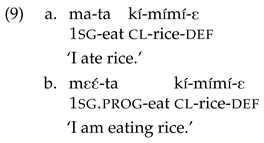
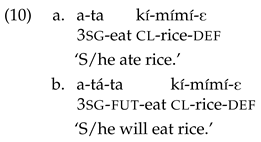
2.2. Questions and Focus
Given that the central focus of this paper concerns extraction, this section has two goals: (i) illustrate basic wh-questions and focus constructions, and (ii) show that they involve movement in Avatime.
2.2.1. Questions
In interrogative constructions, there is an optional Q particle that can appear on the right edge of the clause.3
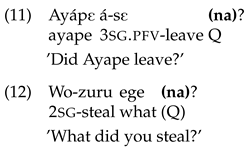
In simple clauses, Avatime allows for wh-in situ and wh-movement. This can be seen by comparing (13b) to (13c).
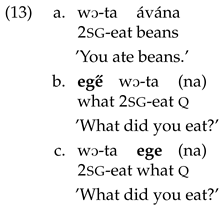
Adjuncts too can occur in situ or be moved into the left peripheral focus position (14a) and (4), where the curly bracketed strings indicate only the distinct locations in the clause where the wh-items can surface.

‘Where did the dogs eat yams?’4
Focused non-wh items display a different pattern. The neutral direct object (13a) and PP in (15a) occur in the post-verbal position. However, their focused counterparts only occur in the left periphery, as (13b) and (15b) show. In addition, the examples show that when a wh-item is fronted to the left periphery, the final vowel is realized with a superhigh tone (as with left peripheral eg in (13b)) versus in situ ege in (13c). In fact, non-wh strings which are focus-fronted also display this property, as can be seen by comparing avana ‘beans’ in (13a) (neutral clause) and when focused (15a) and the (neutral and focused) PP in (15a) and (15b):
in (13b)) versus in situ ege in (13c). In fact, non-wh strings which are focus-fronted also display this property, as can be seen by comparing avana ‘beans’ in (13a) (neutral clause) and when focused (15a) and the (neutral and focused) PP in (15a) and (15b):
 in (13b)) versus in situ ege in (13c). In fact, non-wh strings which are focus-fronted also display this property, as can be seen by comparing avana ‘beans’ in (13a) (neutral clause) and when focused (15a) and the (neutral and focused) PP in (15a) and (15b):
in (13b)) versus in situ ege in (13c). In fact, non-wh strings which are focus-fronted also display this property, as can be seen by comparing avana ‘beans’ in (13a) (neutral clause) and when focused (15a) and the (neutral and focused) PP in (15a) and (15b):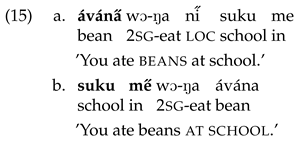
The examples above show that it is the rightmost syllable of the focused constituent that receives the superhigh tone. Van Putten (2014) observes that the superhigh tone is the only realization of focus in Avatime. That is, there is no segmental realization of the focus marker. We take the fact that the high tone focus marker is realized on the rightmost syllable as indicating that the focused item is sitting in the specifier of a left peripheral focus phrase (following Rizzi (1997), Aboh (2005), Major and Torrence (forthcoming)):
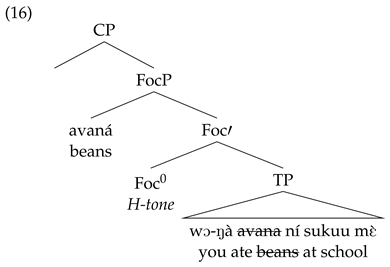
Embedded questions patterns like matrix questions and the wh-item can occur in situ (17a) or in the embedded left peripheral FocP (17b). We note in passing that the question particle seems to be strongly preferred for embedded questions:
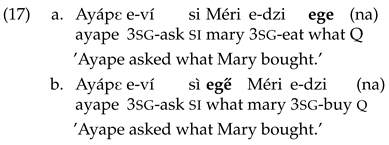
Long distance wh-questions allow for in situ, partial movement, and full movement of arguments and adjuncts:
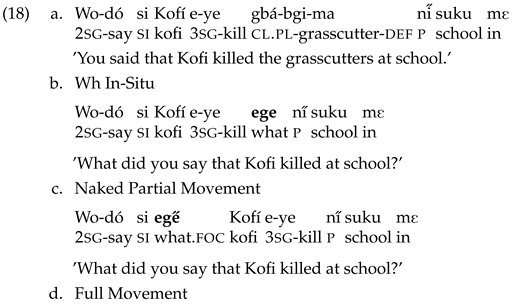

2.2.2. Analyzing Focus
Having argued that left peripheral foci (wh-expressions and non-wh’s) surface in SpecFocP, we now briefly turn to the question of whether left peripheral focus involves movement or base generation of the focused item. Although there is no systematic study of reconstruction effects in Avatime, there is suggestive evidence that the presence of a focused item in the left periphery is the result of movement, not base generation.
One piece of evidence for movement comes from so-called “inherent complement verbs” (ICVs; Aboh and Dyakonova (2009); Essegbey (1999); Korsah (2014), a.o.), which consist of a verb and a nominal element, which together form a lexical unit. IVCs are widespread across the Kwa languages, such as Ga and Ewe (19) and Igbo (20)–(21):
| (19) | a. | Kwei jo foi | (Korsah 2014, (5a)) Ga |
| kwei run race.ic | |||
| ‘Kwei ran.’ | |||
| b. | Kwei wo awulá lŋaa | (Korsah 2014, (5b)) Ewe | |
| kwei icv lady def advice.ic | |||
| ‘Kwei advised the lady’ |
| (20) | a. | tu̥-lányá | (Anyanwu 2012, (2a)) Igbo |
| hit-at.eye.ic | |||
| ‘be surprised’ | |||
| b. | tu̥-òmú | (Anyanwu 2012, (2b)) Igbo | |
| hit-palmfrond.ic | |||
| ‘summon’ |
| (21) | Chíkē ǹtù̩r̩ | Àdhá ó̥mú̥ | (Anyanwu 2012, (14b)) Igbo |
| Chike pr.summon.past Adha palmfrond.ic | |||
| ‘Chike summoned Adha’ | |||
In Avatime, the verbal element may occur with different inherent complement nouns, yielding different meanings. Two of the ICVs below (22a)–(22b) involve the verbal root gu, whose meaning is unclear. Instead, the inherent complement nominals specify the meaning of the entire predicate. The ICVs in (22b) and (22c) both involve the nominal complement ku-nugu-yo, while the verbs are different. In these cases, it looks like the verb is the meaning-specifying element differentiating the verbal predicates:
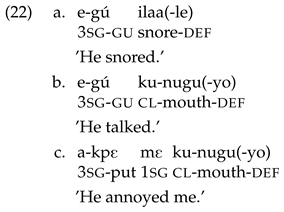
Note that, while nugu is the root for “mouth”, the word for the body part “mouth” is o-nugu-lo, with a different noun class prefix (o-) and final definite article -lo than the word ku-nugu-yo in (22b)–(22c) above. Critically, it is the unique verb and inherent nominal complement that together form the ICV. Drawing from the literature on idioms, we take it that the inherent complement is merged within VP. If the parts of the verbal predicate surface nonlocally, then this is the result of movement. We note that there is a longstanding debate in the literature as to the extent of the idiomaticity of ICVs (Essegbey 1999). Consider the Avatime ICV below, where the string corresponding to “sleep” is composed of the verb dɔ and noun srasɛ:

Example (23b) shows that the inherent nominal complement (sras ) can surface the left peripheral focus position, split from its selecting verb, and the ICV meaning is preserved. This can be accounted for if the focused inherent noun is merged as the complement of the verb dɔ “sleep” and raises to its surface position. Similar evidence comes from idiom chunks, like (24a), which is ambiguous and has both an ordinary expected meaning and an idiomatic reading:
) can surface the left peripheral focus position, split from its selecting verb, and the ICV meaning is preserved. This can be accounted for if the focused inherent noun is merged as the complement of the verb dɔ “sleep” and raises to its surface position. Similar evidence comes from idiom chunks, like (24a), which is ambiguous and has both an ordinary expected meaning and an idiomatic reading:
 ) can surface the left peripheral focus position, split from its selecting verb, and the ICV meaning is preserved. This can be accounted for if the focused inherent noun is merged as the complement of the verb dɔ “sleep” and raises to its surface position. Similar evidence comes from idiom chunks, like (24a), which is ambiguous and has both an ordinary expected meaning and an idiomatic reading:
) can surface the left peripheral focus position, split from its selecting verb, and the ICV meaning is preserved. This can be accounted for if the focused inherent noun is merged as the complement of the verb dɔ “sleep” and raises to its surface position. Similar evidence comes from idiom chunks, like (24a), which is ambiguous and has both an ordinary expected meaning and an idiomatic reading: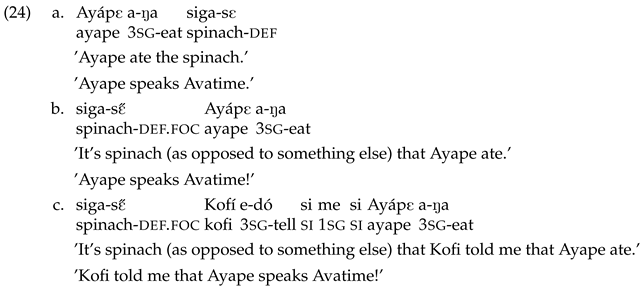
Examples (24b)–(24c) show that the idiomatic object of the verb “eat” can occur in the local and nonlocal SpecFocP (since the rightmost syllable of the focused string has the focus high tone). In both cases, the idiomatic reading is possible. We take this pattern as providing further initial evidence that constituents in the left peripheral focus position surface there as a result of movement, given that they can reconstruct.
2.3. Serial Verb Constructions
2.3.1. Background
As mentioned in the introduction, we argue that constructions involving si ’say’ are actually instances of verb serialization (Major and Torrence 2020). In the most comprehensive study of serialization in Avatime, Defina (2016) describes four different types of Serial Verb Constructions (henceforth SVCs), which vary with respect to morphosyntactic and/or semantic properties. For present purposes, we focus on what Defina refers to as ‘Nuclear SVCs’, which are more ‘protypical’ West African SVCs, which (she describes as (very roughly) involving modification of the main verb by encoding posture, manner and path/activity, complex paths, or theme marking (pp. 107–12), shown in (25a) and (25b).
| (25) | a. | bi-lila kú li-fu=nè. |
| 3pl-vanish enter cl-sky=def | ||
| ‘They vanished into the sky.’ (Defina 2016, 652, ex:4) | ||
 | ||
| ‘He threw it to the old man.’ (Defina 2016, 652, ex:6) | ||
For present purposes, the precise syntactic structure that we adopt for serial verb constructions is not critical, although we do suggest an analysis in Section 3. What is critical at this point is that extraction from either VP is possible in an SVC. For instance, the direct object of “take” or the indirect object of “give” are viable targets for wh-extraction (26).
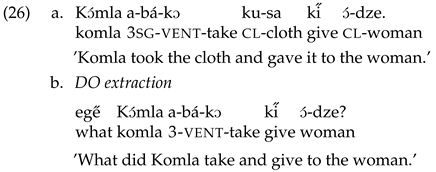
- c.
- IO Extraction5

The fact that SVCs are transparent for extraction has been discussed in a variety of languages (Baker 1989; Hale 1991; Stahlke 1970, a.o.). The precise reason that SVCs are transparent is an important question, but one that we do not address at length in this paper. Regardless of the reason for transparency, if we take si clauses to be SVCs, extraction is predicted to be possible out of a si clause, which we show to be the case.
2.3.2. “Say” Serialization
Major and Torrence (2020) and Major (2021) argue that the syntactic structure for (27a) is quite different from the structure in (27b). They suggest that the former is a classic case of clausal complementation, where the verb si “say” takes a CP complement. The latter involves the verb do “tell/say” forming an SVC with si, the latter being the only predicate in the language that can directly take a CP complement. Note that in (27a), where the matrix verbs is si “say”, the “complementizer” si is not permitted. However, in 27b, where the verb is do ‘tell’, si is required:6
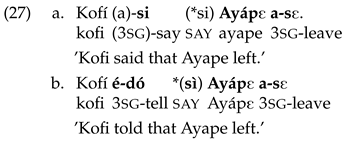
The existence of languages where embedded clauses are canonically introduced by an element homophonous with (a synhcronic or diachronic form of) a verb meaning “say” has been long explored in the literature Lord (1976), Lord (1993), where such structures have often been treated as a diachronic accident. That is, elements such as si are simply complementizers like English “that”, which arose from distinct diachronic sources (i.e., verb versus demonstrative). In other words, both English “that” clauses and “say” clauses correspond to the structures in (28).
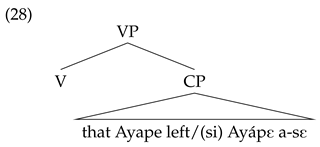
Based on this analysis, there is no structural relationship between the main verb si “say” in (27a) and the “complementizer” si in (27b). The prediction under such an analysis is that CP complements to si in the former case and do in the latter case are equivalent CPs. As a result, they should exhibit the same syntactic properties as “that” clauses. Furthermore, this approach requires an explanation for why we do not find si si when “say” is used as a main verb (the same pattern generally holds cross-linguistically). This is generally treated as a haplology constraint that bans two adjacent realizations of segmentally identical elements. Under the ‘say’-based approach, two instances of si are ruled out for the same reason we do not generally find serial verb constructions with two instances of the same verb – redundancy.
Major and Torrence (2020) provide a number of reasons to assume that the traditional complementation analysis for si clauses in Avatime is not on the right track. First, the wh-expression corresponding to the complement of si is distinct from the complements of other predicates. Notice that ègé “what” is the wh-expression that corresponds to the internal argument of si “say” (29a), dzi “buy” (29b), but not do “say” (29c).
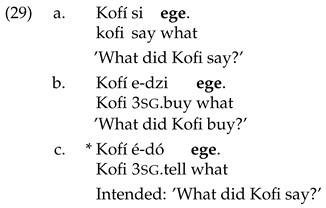
The internal argument of predicates like do “say” and te “know” corresponds to the wh-expression liboe w -lí “which issue” (30a)–(30b), which is incompatible with si “say” (30c).
-lí “which issue” (30a)–(30b), which is incompatible with si “say” (30c).
 -lí “which issue” (30a)–(30b), which is incompatible with si “say” (30c).
-lí “which issue” (30a)–(30b), which is incompatible with si “say” (30c).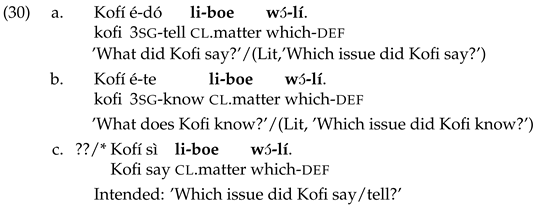
However, when do “say” is followed by si, the internal argument of si corresponds to ege, not liboe w -lí (31):
-lí (31):
 -lí (31):
-lí (31):
Taking stock, among communication/attitude verbs, only si takes a complement that corresponds to ege “what”, while all others take a complement corresponding to liboe w -lí “which issue”. This includes cases like (31), where si introduces its own complement. This is fully incompatible with an analysis by which si is the head of the complement of, e.g., do. However, this pattern falls out quite naturally if “say” is a verb that selects a different type of complement than the verbs that “say” occurs with.
-lí “which issue”. This includes cases like (31), where si introduces its own complement. This is fully incompatible with an analysis by which si is the head of the complement of, e.g., do. However, this pattern falls out quite naturally if “say” is a verb that selects a different type of complement than the verbs that “say” occurs with.
 -lí “which issue”. This includes cases like (31), where si introduces its own complement. This is fully incompatible with an analysis by which si is the head of the complement of, e.g., do. However, this pattern falls out quite naturally if “say” is a verb that selects a different type of complement than the verbs that “say” occurs with.
-lí “which issue”. This includes cases like (31), where si introduces its own complement. This is fully incompatible with an analysis by which si is the head of the complement of, e.g., do. However, this pattern falls out quite naturally if “say” is a verb that selects a different type of complement than the verbs that “say” occurs with.2.3.3. Analysis of SVCs
Major and Torrence (2020) analyze both prototypical SVCs and “say” SVCs as adjunction structures (reminiscent of the analysis in Déchaine (1993)). Thus, the analysis for both (32a) and (32b) is provided in (33).7

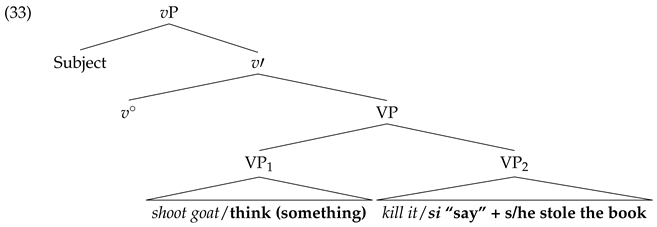
One question that the glossing in (32b) (and hence the analysis in (33)) raises is with regard to the status of si. If the si is a verb meaning ‘say’ in a serial construction in (31b), then we would expect it to have, for example, an external argument. This issue arises because, as pointed out by a reviewer, subject sharing is a canonical property of SVCs (Aikhenvald 2018; Awoyale 1988; Campbell 1996; Carstens 2002; Collins 1997; Stewart 2001; Veenstra and Muysken 2017). Given this, one may wonder in what sense ‘Kofi’ in (32b) performs an act of ‘saying’, especially since the English translation involves only the verb ‘think’ and not ‘say’. Going further, (32b) could be truthfully spoken in a situation where Kofi holds a belief that the proposition “Ama stole the book” is true, even though Kofi has not uttered anything. While not definitive, we suggest that the putative problem is based on the assumption that a predicate translated as English ‘say’ invariably corresponds to an event involving an (audible) utterance. It is therefore useful to consider English ‘say’ which, as Major (2021) points out, occurs in a variety of contexts that may or may not involve (audible) utterances (literally or metaphorically):
| (34) | a. | Suspect 2 said that he is guilty. (Major (2021), p. 39, (60c)) |
| b. | {Suspect 2’s sweating/Suspect 2} says that he is guilty. (Major (2021), p. 39, (60b)) | |
| c. | The sign says something important (on it). (Major (2021), p. 43, (66a)) |
For Major (2021), (34a) is an example of what he calls agent Say, while (34b) involves source Say, with (34c) being a case of locative source Say. Building on Grimshaw (2015), Anand et al. (2017), and Major and Stockwell (2021), he points out various morphological, syntactic, and semantic differences between the different ‘flavors’ of ‘say’. What data like (34) above suggest is that ‘say’ in English may correspond to an actual utterance event, but need not do so. In fact, such a reading of (34c) would be fantastical. (We set aside entirely the question of whether the different flavors of ‘say’ should be treated as distinct, accidentally homophonous lexical items, or a single item corresponding to a range of concrete and abstract utterance events). Turning back to Avatime, cases like (27a) seem to correspond to agent Say. At the same time, Avatime allows for uses of the say that look like locative source Say:

Given the perspective in Major (2021), cases like (32b) and (33) involve two verbal predicates. One of these is the verb ‘think’ and the other is (some flavor of) say, where ‘Kofi’ is the external argument of both verbs (For an analytical precedent, see also Koopman and Sportiche (1989), who argue that the logophoric complementizer in Abe (a Kwa language of Côte d’Ivoire) is in fact an instance of the verb ‘say’, which has a subject (i.e., external argument)).
One consequence of the structure in (33) is that it treats the second VP in an SVC as an adjunct, which have been assumed to be islands since Ross (1967). A number of counterexamples to the Adjunct Condition have been noted in the literature since then (e.g., in the related Na-Togo language Ikpana (Kandybowicz et al. (2023))). In particular, Truswell (2007) demonstrates that there is a correlation between the height of adjunction and transparency/opacity. More specifically, lower adjuncts are shown to be transparent for extraction. In our proposal, the adjunction site (VP) is low enough that extraction from SVCs is expected to be possible.8
2.4. Islands
There are two types of islands that we discuss in the following sections: the complex noun phrase constraint (CNPC) and the adjunct condition.
2.4.1. The CNPC
As mentioned in the introduction, the CNPC bans extraction from clausal modifiers to nouns, such as relative clauses and N-complement clauses, shown, respectively, in (36):
| (36) | a. | I believed the claim [that Otto was wearing this hat]. (Ross 1967, p. 4.17a) |
| b. | * The hat which I believed the claim [that Otto was wearing ] is red. (Ross 1967, p. 4.18a) | |
| c. | Phineas knows a girl [who is jealous of Maxine] (Ross 1967, p. 4.14a) | |
| d. | * Who does Phineas know a girl [who is jealous of ]? (Ross 1967, p. 4.15a) |
Despite the crosslinguistic robustness of the CNPC, there are a number of cases reported in the literature that present apparent violations of it (including recent work in this volume, such as Schurr et al. (2024), Korsah and Murphy (2024), Smith (2024), Hein (2024), but also (Allwood 1976; Cinque 2010; Culy 1990; Davies and Dubinsky 2003; Engdahl 1997; Erteschik-Shir 1973; Kush et al. 2019; Sichel 2018; Taraldsen 1982)), such as (37). For some, these exceptions have been interpreted as evidence against syntax being responsible for locality, while others have sought to explain these exceptions.
| (37) | a. | ? The money which I am making the claim [that the company squandered __] amounts to $400,000. (Ross 1967, p. 4.43a) |
| b. | Then you look at what happens in languages that you know and languages1 that you have a [friend who knows t1]. (McCawley 1981, p. 108) | |
| c. | This is the child1 that there is [nobody who is willing to accept t1]. | |
| (Kuno 1976, p. 423) |
In recent work, Sichel (2018) explicitly engages with exceptions to the CNPC across a wide variety of typologically unrelated languages. Sichel (2018) suggests that there is a correlation between the derivation of particular relative clauses and extractability. More specifically, she argues that both “Raising” RCs and “Matching” RCs exist and give rise to distinct extraction patterns.
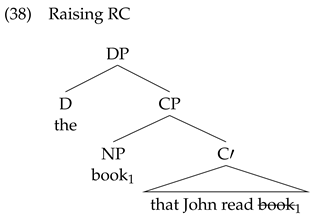
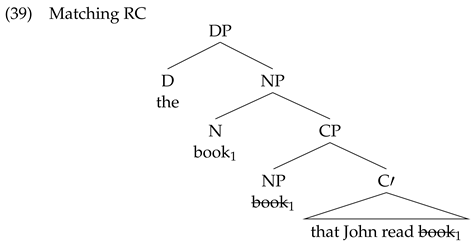
Sichel (2018) argues that because the head NP in a raising RC is situated in Spec, CP (following Kayne 1994), a phrase embedded under CP will cross the DP layer, but not the NP node. In the case of the matching RC, both NP and DP layers must be crossed. She thus argues that (like wh-islands) it is possible to extract from the former in some circumstances, while the latter remains impossible to extract from. She shows that, crucially, languages that allow extraction from raising RCs do not allow extraction from N-comp configurations. In other words, it is the precise structural properties that determine whether extraction will be allowed.
With this, we turn to the primary focus of the present paper: (apparent) CNPC violations in Avatime. In the section that follows, we show that unlike Hebrew, extraction from RCs is not possible in Avatime. However, it appears that extraction from N-comp constructions is possible, which should remain a strong island given Sichel (2018)’s analysis. In the same spirit, we suggest that these exceptions are only apparent, as extraction takes place from the second clause of a serial verb construction, not from a CP complement to a noun. As a result, extraction properties should mirror those of serial verb constructions, which are widely known to be transparent (as shown in Section 3.3).
2.4.2. Approaching Adjunct Islands
The serialization analysis in (33) suggests that serialization involves a VP with two VPs as daughters. Therefore, extraction from VP2, the adjunct, should be excluded by the adjunct condition. Consider the definitions of adjuncts and adjunct islands from Johnson (2003), provided below:


Whether SVCs qualify as adjuncts based on the definition in (40) is unclear. More specifically, because both sisters are VPs, it is difficult to say conclusively that one does (or does not) project. However, if only one VP projects, extraction should always be possible out of (at least) that VP. This is precisely the approach taken by Privoznov (2022) for converbial clause modifiers in Balkar (Turkic), where it is argued that when two sisters are of the same category, one must project, while the other is spelled out and is thus rendered opaque for extraction.9
In addition to the spell-out-based analysis of extraction from adjuncts mentioned above, there are also semantics-based discussions in the literature. Truswell (2007, 2011) investigates cases like (42), which appear to involve extraction from adjuncts. He argues that there is a relationship between event structure and the ability to extract from an adjunct and proposes the generalization in (43) to account for cases like (42). (In Truswell (2011) the generalization in Truswell (2007) is subsumed under the Single Event Constraint):

- (43)
- (Truswell 2007, p. 1374)Extraction of a complement from a secondary predicate is permitted only if the event denoted by the secondary predicate is identified with an event position in the matrix predicate.
Under Truswell (2011)’s approach, adjunct opacity/transparency is determined by a semantic relationship, while Privoznov (2022) argues that it is structurally conditioned. For our purposes, what is important is simply that low adjuncts that form a semantically “tight” relationship with the main VP are not subject to the adjunct condition. Serial verb constructions are often said to form a “single event” and, thus, it is unsurprising that they would not function as islands for extraction.10
3. Islands in Avatime
We now turn to the status of the CNPC in Avatime, which is the main focus of the present paper. As noted, it appears that extraction is permitted out of N-complement clauses in Avatime. There are a number of apparent CNPC violations involving extraction from relative clauses in the literature (Sichel 2018), but few (if any) cases involving extraction from N-comp clauses. (For reports on other Niger-Congo languages that allow escape from NCCs, see Schurr et al. (2024), and Hein (2024) in this volume). In this section, we provide data that show that it is possible to extract from what appear to be clausal complements to nouns in Avatime. We show that if we adopt Major and Torrence (2020)’s analysis of ‘say’ complementation, however, these are not actually N-comp configurations. As a result, what appear to be extraction from N-comp clauses are actually instances of extraction from the second VP of an SVC.
Ignoring the the serialization analysis of clausal complementation in Major and Torrence (2020), Avatime appears to show the opposite pattern from the languages discussed by Sichel (2018). More specifically, it appears that relative clauses are islands for extraction, while N-comp constructions are sometimes transparent. In this section, we begin by providing data from relative clauses, then turning to apparent N-comp configurations. We show that even within N-comp configurations, arguments can be extracted, while adjuncts cannot.
3.1. Standard Islands in Avatime
In this section, we first establish that Avatime, obeys some of the well-known constraints on A-bar movement (Ross 1967). Devlin et al. (2021, p. 68) demonstrate that wh-items inside of RCs are permitted, but RCs are opaque for overt extraction.11 (44a) illustrates a prototypical relative clause in Avatime, involving the relative marker gi (following the RC head) and a clause-final determiner (cdet). (We note in passing that clausal determiners are found in a number of related Kwa languages like Krachi (Kandybowicz and Torrence (2019)) and Akan and Ga (Korsah (2017)) and in other unrelated West African languages such as the Chadic language Ngizim (Schuh (1972)). In addition, the head noun and all of its associated determiner-like material precede the relative marker (44a)–(44b). When a subject is relativized, the (noun class-agreeing) subject marker on the verb is still present. When a direct object is relativized, there is a gap in object position. (44b)–(44c) demonstrate that it is possible for an in-situ wh-expression to take matrix scope from within a RC. (44d) shows that overt wh-movement from the same position is prohibited, even if there is a resumptive pronoun (wa) inserted.
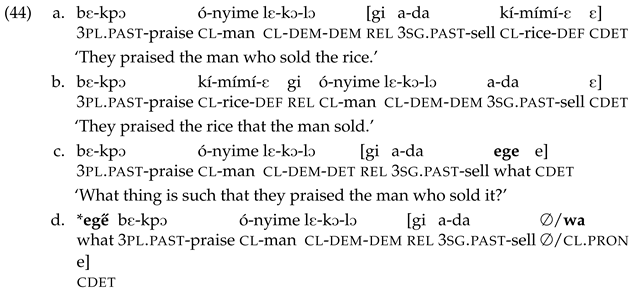
Given that wh-movement out of RCs is prohibited, we can maintain that the CNPC is active in at least some cases in Avatime.
3.2. Adjunct Islands
Avatime also exhibits island sensitivity with (temporal) adjunct clauses. Note that many of the adjuncts that show island effects involve the relative complementizer gi and the clausal determiner. For this reason, these might be relative clauses, in which case they are actually CNPC violations. We leave this as an open question here, but observe that (45) also shows a right-edge clausal determiner in the bracketed temporal adjunct clause.

In situ wh inside of the “until” clause is fine (46a), as is island-internal partial movement (46b):

Just as with relative clauses, movement that crosses an adjunct clause boundary is not possible:
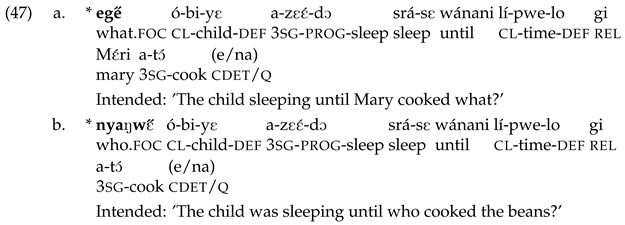
The same pattern is observed for “despite” adjunct clauses (48).
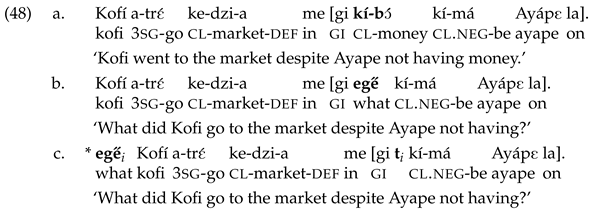
What the data shows is that Avatime wh-in-situ is fine inside of an island, as is partial movement within an island. (See Kandybowicz et al. (2023) for discussion of similar data in Ikpana). We don’t pursue this issue here, but these data raise the question, noted by a reviewer, of whether such constructions are licensed by an operator that A-bar binds the wh-expression or whether there is LF movement of the wh-expression (Szabolcsi and Lohndal 2017). Given that Avatime has a question particle and that it can be absent in a neutral question, it is not immediately clear how Avatime provides confirmation or disconfirmation for either approach. That is, the current data do not allow us to decide how to best account for island-internal wh-expressions in Avatime. We set aside this issue for future research. However, based on the patterns above, it should not be concluded that CNPs and adjuncts are simply not islands in Avatime, as the cases above are islands. An explanation is thus in order to explain where Avatime island effects are found and where they are absent. More specifically, why is it that si clauses are transparent, while gi clauses are opaque for extraction? We turn to what appear to be NCCs now.
3.3. Extraction from NCC-like Constructions?
In this section, we present data that appear to involve grammatical violations to the CNPC (50)–(52).12 An N-comp construction is given in (49). As shown, the “head noun”, which precedes the entire RC, is followed by the element sì that introduces finite embedded clauses. The relative marker, gì, is absent. Further, there is no clausal determiner on the right edge of the modifying embedded clause. In addition, unlike headed RCs, there does not appear to be a gap inside of the modifying clause. That is, the clause-internal predicate is saturated.

Example (50a) shows an NCC clause with the expected configuration. The wh-in situ case in (50b) patterns like headed RCs in that wh-in-situ is fine (the lack of CNPC effects with wh-in situ (50b) is robustly attested cross-linguistically (Huang 1982)). As shown in (50c), island-internal partial movement is also fine. However, the acceptability of overt island-boundary-crossing movement in (50d)–(50e) is surprising:
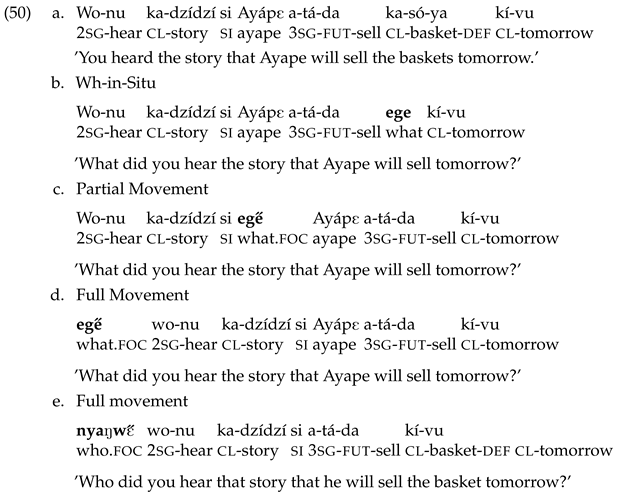
The same pattern is observed for movement of the D-linked wh-phrase “which dogs” out of a clause associated with the head noun legabwe “nonsense” in (51). Examples (51b) and (51c) show that in situ and partial movement (as indicated by the high tone on wolí “which”) inside the NCC are fine. Example (51d) shows that full movement out of the NCC is also fine.
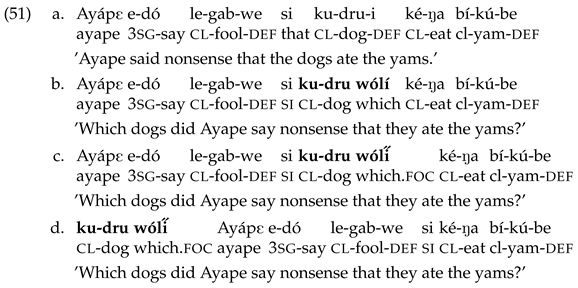
Interrogative predicates, like “ask”, are able to take a nominal argument such as the “question” pattern like the propositional predicates above. As expected, both in situ (52b) and partial movement (52c) are fine within an NCC. In addition, extraction from the clause associated with “question” is possible (52d):
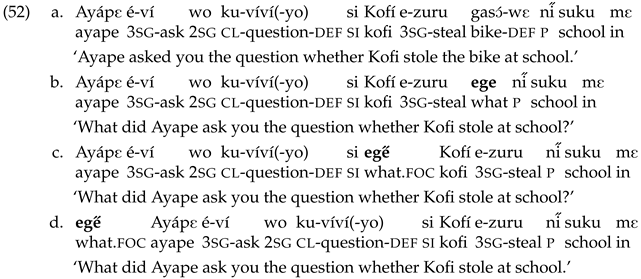
In Avatime, NCCs allow argument extraction and both proposition-selecting and interrogative-selecting verbs pattern the same. We next turn to adjunct extraction from NCCs.
3.4. Adjunct Extraction from si Clauses
Adjuncts pattern differently from arguments with respect to NCC extraction, as they display island sensitivity. Consider first locative adjuncts (53). Just as with arguments, wh-in situ and partial movement are possible in (53a) and (53b). However, full movement out of the NCC is prohibited (53c)13:
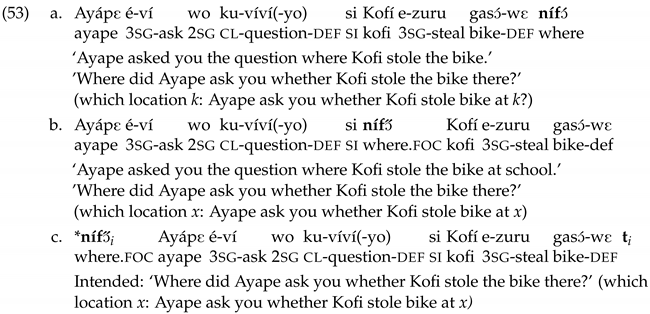
Note that (53c) is ungrammatical under a reading in which the question is about the location of the event of stealing, as the subscripting indicates (it is grammatical if the wh-item is construed as asking about the location of the event of asking). A second example demonstrating the same pattern for a declarative is provided below. Example (54b) shows that argument extraction is permitted, while in (54c), adjunct movement is ungrammatical.
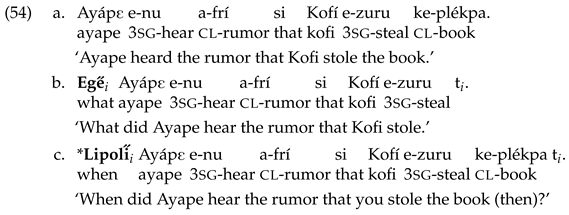
These adjunct clauses, which resemble complex NPs, are selective islands. That is, (53) and (54) are opaque for extraction only for adjunct extraction, not argument extraction.
Recall from (42) that certain low adjuncts are transparent for extraction. Interestingly, these same configurations are islands for extraction of adjuncts in English as well.14

Explaining the argument vs. adjunct asymmetry is outside the scope of the present paper, but these data are at least suggestive that, in principle, the same solution could be responsible for the extraction facts in Avatime and English.
3.5. Analysis
If we take the si clauses in the NCC cases above to constitute traditional N-complement configurations like (56), we should expect extraction from the CP complement to N to be prohibited, contrary to fact.
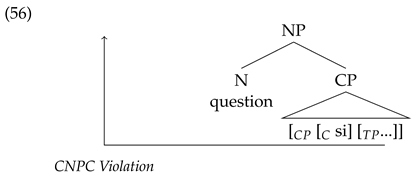
If we assume this to be the structure for the cases in (50)–(52), these data would suggest that the CNPC does not hold for N-comp constructions in Avatime. Given that N-comp constructions are generally assumed to be strong islands, it would be difficult to justify these exceptions as resulting from raising derivations in the way that Sichel suggests for RCs. Also striking is the fact that RCs themselves are subject to the CNPC in Avatime, which would give rise to the opposite pattern described by Sichel (2018).
An alternative possibility is that we adopt Major and Torrence (2020)’s analysis of si clauses (33), as illustrated in (57), in which case the problem disappears. Based on this analysis, the “say” clause modifies the entire matrix VP and involves a serial verb configuration. That is, the embedded clause is not complement to N. As a result, extraction is expected to be possible because extraction is possible from SVCs.

Stated in other words, the structure in (57) does not contain a complex noun phrase. As a consequence, we are able to maintain at least Sichel (2018)’s version of the CNPC. This offers theory-internal support for the SVC analysis of Avatime si clauses.
In addition to theory-internal support, there is further evidence in favor of (57), which comes from constituency. More specifically, as was the case in (29a), it is possible to target the complement to si in a wh-question (58).

Assuming a traditional N-comp analysis of (58), one would need to make the assumption that the complement to the head noun would be a CP constituent that does not contain si, the precise head that looks like si. Under such an analysis, ege “what” would correspond to TP. We are also unaware of any language that has a TP-corresponding wh-expression. Assuming the SVC analysis, si is a verb that introduces a CP complement, ege corresponds to CP, and no further stipulation is necessary.
4. Conclusions
In this paper, we demonstrated that Avatime allows for selective island violations. We suggest that what appear to be NCCs in Avatime are only apparent—constructions involving the element si “say” actually represent serial verb constructions, which are independently known to allow extraction. Despite argument extraction being permissible, adjuncts cannot be A-bar extracted from these “say” clauses. This asymmetry between arguments and adjuncts has been noted for other languages, including English. Our proposal suggests that these are actually a type of weak adjunct island. This contrasts with true RCs in the language involving, e.g., the complementizer gi. The serialization-type analysis of “say” clauses offers an explanation for why they could show differences with respect to transparency when compared to, e.g., gi clauses. Although there is far more work to be carried out even within Avatime, we suggest that “say” clauses should receive special attention in future work on islandhood cross-linguistically. As this volume demonstrates, many African languages introduce challenges to our conception of islands. This paper suggests that at least some of these exceptions are only apparent. This paper offers a potential explanation for why “say” clauses, in particular, might prove to be more likely to be transparent, given their status as weak islands.
Author Contributions
Conceptualization, T.M and H.T.; investigation, T.M. and H.T.; writing–review and editing, T.M. and H.T. All authors have read and agreed to the published version of the manuscript.
Funding
This research received no external funding.
Institutional Review Board Statement
Not applicable.
Informed Consent Statement
Informed consent was obtained from all subjects involved in the study.
Data Availability Statement
Data is contained within the article.
Acknowledgments
We thank the native speaker language consultants for sharing their language and insights with us: Vincent Azafokpe, Divine Agyepong, Peace Awunyama, Jones Kwame, Paul Kwawu, and Akos Mawulorm. We also thank two anonymous reviewers and editor Jason Kandybowicz, whose comments have helped to shape this paper.
Conflicts of Interest
The authors declare no conflicts of interest.
Notes
| 1 | For a more careful discussion of Avatime tones, see Defina (2016); Ford (1971); Schuh (1995); Van Putten (2014). We have omitted the so-called “tone 2” (the mid-tone). |
| 2 | The distribution and semantic contribution of the “def”(inite) suffixes is not clear. |
| 3 | The semantic or pragmatic contribution of this particle is unclear. We note its existence here, but leave it as a topic for future research. |
| 4 | When ‘where’ is focused, the ni is dropped. As pointed out by a reviewer, the disappearence of the Locative marker under A-bar movement of the PP in Avatime is reminiscent of what happens in Dinka Bor, a Nilo-Saharan language of South Sudan. Van Urk (2015) shows that when a PP A-bar moves, it triggers oblique voice morphology on the verb and the preposition disappears. The oblique voice morphology is identical to the preposition that disappears in both form and allomorphic behavior. |
| 5 | When the complement of ki is moved, it is realized as kɔ. |
| 6 | We gloss si as ‘say’ when it functions as the sole embedding verb and as say in the second position to represent its light-verb like qualities and bleached semantics in this position. |
| 7 | The basic facts in this paper would be compatible with a complementation analysis of SVCs in line with Collins (1997). |
| 8 | We leave the precise reason that low adjuncts are transparent for extraction to future research, but direct the reader to Privoznov (2021, 2022) for a recent proposal and discussion. |
| 9 | It is unclear how Privoznov (2022)’s analysis accounts for straightforward cases of ATB. For instance, if only one VP projects and the other is rendered opaque for movement, it unclear how ATB is possible:
 |
| 10 | See Defina (2016) for more detailed discussion of Avatime SVCs, event structure, and beyond. |
| 11 | Kandybowicz et al. (2023) report similar facts for Ikpana. |
| 12 | Because we ultimately argue that these are not actually an N-comp construction, we describe the CPs as “associated with” the head noun, not as complements to the head noun. |
| 13 | The locative marker ni, which precedes the postpositional object, does not occur when the PP is focused. However, its high tone remains and is realized on the first syllable of the postpositional object. |
| 14 | We would like to thank Zeljko Boskovic for bringing this fact to our attention. In Bošković (2015), adjunct extraction is used to more clearly illustrate island effects in CNPC contexts. This would be a possible interpretation of the present facts. It should be noted that adjunct extraction is more difficult than arguments in a wide variety of domains, including out of e.g., complements to P (Who did you steal a picture of? vs. * Where did you steal a picture of John standing?). |
References
- Aboh, Enoch Oladé. 2005. Object shift, Verb movement and Verb reduplication. In The Oxford Handbook of Comparative Syntax. Edited by G. Cinque and R. S. Kayne. Oxford: Oxford University Press, pp. 138–77. [Google Scholar]
- Aboh, Enoch O., and Marina Dyakonova. 2009. Predicate doubling and parallel chains. Lingua 119: 1035–65. [Google Scholar] [CrossRef]
- Aikhenvald, Alexandra. 2018. Serial verbs. Oxford: Oxford University Press. [Google Scholar]
- Allwood, Jens S. 1976. The complex NP constraint as a non-universal rule and some semantic factors influencing the acceptability of swedish sentences which violate the cnpc. University of Massachusetts Occasional Papers in linguistics 2: 2. [Google Scholar]
- Anand, Pranav, Jane Grimshaw, and Valentine Hacquard. 2017. Sentence embedding predicates, factivity and subjects. In Lauri Karttunen Festschrift. Edited by C. Condoravdi. Stanford: CSLI, pp. 1–29. [Google Scholar]
- Anyanwu, Ogbonna. 2012. The syntax and semantics of inherent complement verbs in Igbo. Theory & Practice in Language Studies (TPLS) 2: 1561–69. [Google Scholar]
- Awoyale, Yiwola. 1988. Complex Predicates and Verb Serialization. Lexicon Project, Center for Cognitive Science. Cambridge: MIT. [Google Scholar]
- Baker, Mark C. 1989. Object sharing and projection in serial verb constructions. Linguistic Inquiry 20: 513–54. [Google Scholar]
- Bošković, Željko. 2015. From the complex NP constraint to everything: On deep extractions across categories. The Linguistic Review 32: 603–69. [Google Scholar] [CrossRef]
- Campbell, Richard. 1996. Serial verbs and shared arguments. Linguistic Review 13: 83–118. [Google Scholar] [CrossRef]
- Carstens, Vicki. 2002. Antisymmetry and word order in serial constructions. Language 2002: 3–50. [Google Scholar] [CrossRef]
- Chomsky, Noam. 1982. Some Concepts and Consequences of the Theory of Government and Binding. Cambridge: MIT Press. [Google Scholar]
- Cinque, Guglielmo. 2010. On a selective “violation” of the complex NP constraint. In Structure Preserved. Studies in Syntax for Jan Koster. Amsterdam: John Benjamins Publishing Company, pp. 81–90. [Google Scholar]
- Collins, Chris. 1997. Argument sharing in serial verb constructions. Linguistic Inquiry 28: 461–97. [Google Scholar]
- Culy, Christopher Douglas. 1990. The Syntax and Semantics of Internally Headed Relative Clauses. Stanford: Stanford University. [Google Scholar]
- Davies, William D., and Stanley Dubinsky. 2003. On extraction from NPs. Natural language & linguistic theory 21: 1–37. [Google Scholar]
- Déchaine, Rose-Marie Anne. 1993. Predicates across Categories: Towards a Category-Neutral Syntax. Amherst: University of Massachusetts Amherst. [Google Scholar]
- Defina, Rebecca. 2016. Events in Language and Thought: The Case of Serial Verb Constructions in Avatime. Ph.D. thesis, MPI, Nijmegen, The Netherlands. [Google Scholar]
- Devlin, Kerri, Blake Lehman, Travis Major, and Harold Torrence. 2021. A note on wh-questions in Avatime. In Celebrating 50 Years of ACAL. Berlin: Language Science Press, pp. 55–72. [Google Scholar]
- Engdahl, Elisabet. 1980. The Syntax and Semantics of Questions in Swedish. Ph.D. thesis, University of Massachusetts, Amherst, MA, USA. [Google Scholar]
- Engdahl, Elisabet. 1997. Relative clause extractions in context. Working Papers in Scandinavian Syntax 60: 51–79. [Google Scholar]
- Erteschik-Shir, Nomi. 1973. On the Nature of Island Constraints. Ph.D. thesis, Massachusetts Institute of Technology, Cambridge, MA, USA. [Google Scholar]
- Essegbey, James. 1999. Inherent Complement Verbs Revisited: Towards an Understanding of Argument Structure in Ewe. Ph.D. thesis, Radboud University Nijmegen, Nijmegen, The Netherlands. [Google Scholar]
- Ford, Kevin C. 1971. Aspects of Avatime Syntax. Ph.D. Thesis, University of Ghana, Accra, Ghana. [Google Scholar]
- Grimshaw, Jane. 2015. The light verbs say and SAY. In Structures in the Mind: Essays on Language, Music, and Cognition in Honor of Ray Jackendoff. Cambridge: The MIT Press, pp. 79–99. [Google Scholar]
- Hale, Ken. 1991. Misumalpan verb sequencing constructions. In Serial verbs: Grammatical, Comparative and Cognitive Approaches. Amsterdam: John Benjamins Publishing Company, pp. 1–35. [Google Scholar]
- Hein, Johannes. 2024. Category-sensitive escape from islands in Limbum and Asante Twi. Languages 9: 317. [Google Scholar] [CrossRef]
- Huang, C.-T. James. 1982. Logical Relations in Chinese and the Theory of Grammar. Ph.D. Thesis, Massachusetts Institute of Technology, Cambridge, MA, USA. [Google Scholar]
- Johnson, Kyle. 2003. Towards an etiology of adjunct islands. Nordlyd 31: 187–215. [Google Scholar] [CrossRef] [PubMed][Green Version]
- Kandybowicz, Jason, Bertille Baron, Philip T. Duncan, and Hironori Katsuda. 2023. Ikpana Interrogatives. Oxford: Oxford Uniersity Press. [Google Scholar]
- Kandybowicz, Jason, and Harold Torrence. 2019. A first look at Krachi clausal determiners. In Schuhschrift:Papers in Honor of Russell Schuh. Edited by M. Bowler, P. T. Duncan, T. Major and H. Torrence. Los Angeles: eScholarship Publishing, pp. 66–76. [Google Scholar]
- Kayne, Richard S. 1994. The Antisymmetry of Syntax. Cambridge: MIT Press. [Google Scholar]
- Koopman, Hilda, and Dominique Sportiche. 1989. Pronouns, Logical Variables, and Logophoricity in Abe. Linguistic Inquiry 20: 555–88. [Google Scholar]
- Korsah, Sampson. 2014. On inherent complement verbs in Kwa. Linguistische Arbeits Berichte, Topics at InfL 92: 397–422. [Google Scholar]
- Korsah, Sampson. 2017. Issues in Kwa Syntax: Pronouns and Clausal Determiners. Ph.D. thesis, Leipzig University, Leipzig, Germany. [Google Scholar]
- Korsah, Sampson, and Andrew Murphy. 2024. The absence of islands in Akan: The role of resumption. Languages 9: 127. [Google Scholar] [CrossRef]
- Kuno, Susumu. 1976. Gapping: A functional analysis. Linguistic Inquiry 7: 300–18. [Google Scholar]
- Kush, Dave, Terje Lohndal, and Jon Sprouse. 2019. On the island sensitivity of topicalization in Norwegian: An experimental investigation. Language 95: 393–420. [Google Scholar] [CrossRef]
- Kush, Dave, Akira Omaki, and Norbert Hornstein. 2013. Microvariation in islands? Experimental Syntax and Island Effects 11: 239. [Google Scholar]
- Lehman, Blake. 2024. Topics in Avatime Phonology. Ph.D. thesis, University of California Los Angeles, Los Angeles, CA, USA. [Google Scholar]
- Lord, Carol. 1976. Evidence for syntactic reanalysis: From verb to complementizer in Kwa. Papers from the Parasession on Diachronic Syntax 1976: 179–91. [Google Scholar]
- Lord, Carol. 1993. Historical Change in Serial Verb Constructions. Amsterdam: John Benjamins Publishing, vol. 26. [Google Scholar]
- Major, Travis. 2021. On the Nature of “Say” Complementation. Ph.D. thesis, UCLA, Los Angeles, CA, USA. [Google Scholar]
- Major, Travis, and Richard Stockwell. 2021. “Say”-ing without a Voice . In Proceedings of NELS51. Place: UQAM. [Google Scholar]
- Major, Travis, and Harold Torrence. 2020. “Say”-Chains, Not “Say”-Complementation. In Proceedings of the 38th West Coast Conference on Formal Linguistics. Somerville: Cascadilla Proceedings Projects. [Google Scholar]
- Major, Travis, and Harold Torrence. forthcoming. Picking up a friend along the way: A’-movement through the v/VP region in Avatime. Accepted in Linguistic Inquiry.
- McCawley, James D. 1981. The syntax and semantics of English relative clauses. Lingua 53: 99–149. [Google Scholar] [CrossRef]
- Privoznov, Dmitry. 2021. A Theory of Two Strong Islands. Ph.D. thesis, Massachusetts Institute of Technology, Cambridge, MA, USA. [Google Scholar]
- Privoznov, Dmitry. 2022. Adjunct islands are configurational. Glossa: A journal of General Linguistics 7: 1–47. [Google Scholar] [CrossRef]
- Rizzi, Luigi. 1997. The fine structure of the left periphery. In Elements of Grammar. Edited by L. Haegeman. Dordrecht: Kluwer Academic Publishers, pp. 281–337. [Google Scholar]
- Ross, John. 1967. Constraints on Variables in Syntax. Ph.D. thesis, Massachusetts Institute of Technology, Cambridge, MA, USA. [Google Scholar]
- Schuh, Russell. 1972. Aspects of Ngizim Syntax. Ph.D. thesis, University of California Los Angeles, Los Angeles, CA, USA. [Google Scholar]
- Schuh, Russell G. 1995. Aspects of Avatime phonology. Studies in African Linguistics 24: 31–67. [Google Scholar] [CrossRef]
- Schurr, Hagay, Jason Kandybowicz, Abdoulaye Laziz Nchare, Tysean Bucknor, Xiaomeng Ma, Magdalena Markowska, and Armando Tapia. 2024. Absence of clausal islands in Shupamem. Languages 9: 7. [Google Scholar] [CrossRef]
- Sichel, Ivy. 2018. Anatomy of a counterexample: Extraction from relative clauses. Linguistic Inquiry 49: 335–78. [Google Scholar] [CrossRef]
- Smith, Jason D. 2024. On the absence of certain island effects in Mende. Languages 9: 131. [Google Scholar] [CrossRef]
- Stahlke, Herbert. 1970. Serial verbs. Studies in African linguistics 1: 60. [Google Scholar]
- Stewart, Osamuyimen Thompson. 2001. The Serial Verb Construction Parameter. Abingdon: Routledge. [Google Scholar]
- Szabolcsi, Anna, and Terje Lohndal. 2017. Strong vs. Weak Islands. In The Blackwell Companion to Syntax, 2nd ed. New York: John Wiley & Sons. [Google Scholar]
- Taraldsen, Knut Tarald. 1982. Extraction from relative clauses in Norwegian. Readings on unbounded dependencies in Scandinavian languages 43: 205. [Google Scholar]
- Truswell, Robert. 2007. Extraction from adjuncts and the structure of events. Lingua 117: 1355–77. [Google Scholar] [CrossRef]
- Truswell, Robert. 2011. Events, Phrases, and Questions. Oxford: Oxford University Press. [Google Scholar]
- Van Putten, Saskia. 2014. Information Structure in Avatime. Ph.D. Thesis, Radboud University, Nijmegen, The Netherlands. [Google Scholar]
- Van Urk, Coppe. 2015. A Uniform Syntax for Phrasal Movement: A Case Study of Dinka Bor. Ph.D. thesis, Massachusetts Institute of Technology, Department of Linguistics and Philosophy, Cambridge, MA, USA. [Google Scholar]
- Veenstra, Tonjes, and Pieter Muysken. 2017. Serial verb constructions. In The Wiley Blackwell Companion to Syntax, 2nd ed. Hoboken: Wiley, pp. 1–51. [Google Scholar]
Disclaimer/Publisher’s Note: The statements, opinions and data contained in all publications are solely those of the individual author(s) and contributor(s) and not of MDPI and/or the editor(s). MDPI and/or the editor(s) disclaim responsibility for any injury to people or property resulting from any ideas, methods, instructions or products referred to in the content. |
© 2024 by the authors. Licensee MDPI, Basel, Switzerland. This article is an open access article distributed under the terms and conditions of the Creative Commons Attribution (CC BY) license (https://creativecommons.org/licenses/by/4.0/).